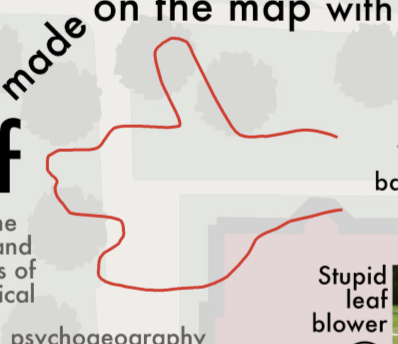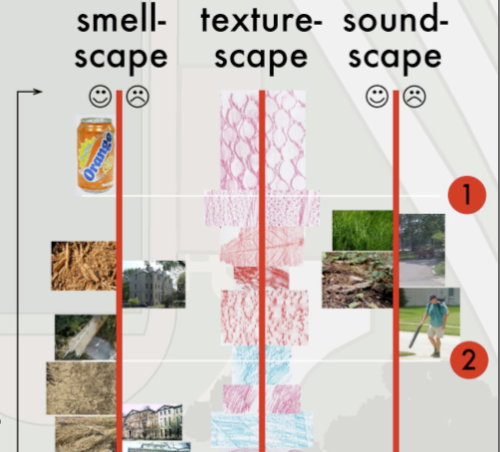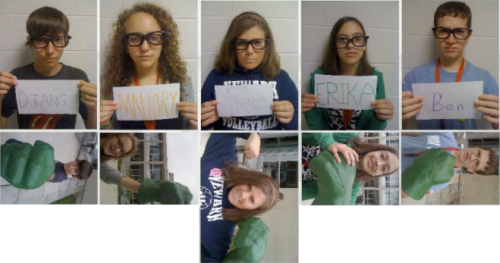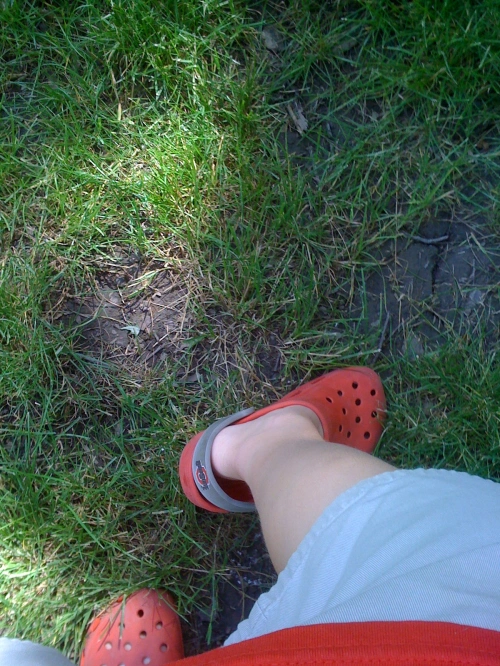Making Maps: DIY Cartography
Resources and Ideas for Making Maps
Making Psychogeography Maps
June 22, 2009 by John Krygier
Guide Psychogéographique de OWU (2009, med res jpg)
•••••
During the week of June 15-19 (2009) five intrepid Ohio students and myself engaged in improvisational psychogeography, culminating in the map opening this post. A printable 11″ x 17″ (300dpi 1.4mb) PDF of the map is here.
•••
Map detail: The path taken through campus followed the outline of a wolfie hand-shadow cast on a campus map.
•••
Map detail: Stuff smelt, heard, and felt with its allure or disallure indicated with faces.
•••
The map was the product of a course – Mapping Weird Stuff – I offered at theOWjL (Ohio Wesleyan University Junior League of Columbus) summer camp for gifted and talented middle school students.
Based on the kid’s ideas and work collecting diverse data, I designed a layout and look for the map. The map itself was created in FreehandMX, now dead-tech thanks to Adobe (I still prefer Freehand even though I started with Illustrator back at version 1).
Making the map once again reminded me that it’s fun to make maps, if you haveinteresting stuff to map. The design and layout are certainly nothing one could generate with typical mapping software – thus the use of graphic illustration software. Diverse and interesting maps are not really the domain of web and pc-based map generation software. Maybe sometimes. Not usually.
•••
Map detail: An abstracted linear “map” sequencing smells, textures, and sounds from one end to the other of the path investigated.
•••
My vague intent was to do some kind of weird mapping project on campus – sensory mapping, psychogeography, etc. My search for resources for this age student (grades 6-8) resulted in a few finds, but not much. The materials I compiled on the course blog (here) served as the basis of our work, which developed as the students engaged the ideas. We met for 1.5 hours a day, for 5 days.
•••
Special glasses indicate how serious we were about this project.
The Hulk hand inspired confidence in our powers.
•••
The students, Django, Mallory, McKenna, Erica, and Ben, were great. They jumped into the project, came up with ideas that shaped our direction, and collected all of the data on the map. I had some ideas about what kind of psychogeography we would do, and what kind of map we would create, then it all transmogrified into something else which turned out great.
We did a dérive (“a technique of transient passage through varied ambiances”) to get a feel for the campus and its “resonances,” some blind-folded, ear-plugged tours through the campus (with me or one of the students leading the others along) collecting smells and sounds, as well as a few texture collection expeditions (inspired, in part, by Denis Wood’s Narrative Atlas of Boylan Heights project).
•••
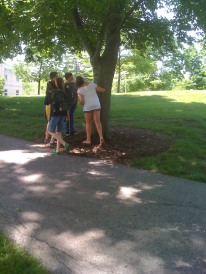
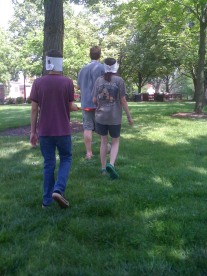
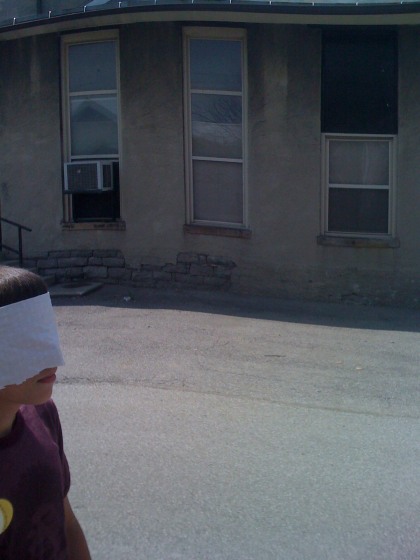

Guiding much of our work was a single, inspiring Hulk hand.
•••
A bit of background on Psychogeography:
Psychogeography, according to its founder Guy Debord, is “the study of the precise laws and specific effects of the geographical environment, consciously organized or not, on the emotions and behavior of individuals.”
In practice, psychogeography inherently resists any narrow definitions. It encompasses diverse activities that raise awareness of the natural and cultural environment, is attentive to senses and emotions as they relate to place and environment, is often political and critical of the status quo, and must be both very serious and fun.
Psychogeography overlaps with Kevin Lynch’s work on mental maps, as nicely reviewed in Denis Wood’s article “Lynch Debord” as well as work on non-visual sensory-scapes (smellscape, soundscape, touchscape, tastescape, etc.).
The most famous psychogeography map is Debord’s Guide Pychogéographique de Paris:
Guy Debord, Guide Pychogéographique de Paris
•••
•••
Posted in 01 What’s A Map?, 02 Why Are You Making Your Map?, 03 Mappable Data, 06 Map Layout, 09 Map Symbolization, Deep Map Thoughts, Maps Made, unMaking Maps | Tagged Maps – Grades 6-8, Maps – Weird, psychogeography, Psychogeography – Grades 6-8, Psychogeography – Lesson Plans, Psychogeography Maps, Sensory Mapping | 17 Comments
17 Responses
-
Very cool project…that inspires me to resurrect something similar I did with first year architecture students a few years ago. Your project was much richer!…and to end it with my favorite “wingding” …the bomb…very nice!
best
Dave -
[…] a really interesting post over on Making Maps: DIY Cartography that talks about a student project to create a psychogeographical map of an area on their campus. […]
-
on August 31, 2009 at 7:01 am | ReplyScents and the City or “I -smell- NY” (NY Times) « Kelso’s Corner
[…] me in university by Judy Walton. I recently posted on Edible Landscape Maps and John has a post on psychogeography […]
-
[…] = “0”; sa_borderwidth = “1”; sa_font = “0”; Over at Making Maps blog, John Krygier posted some great student examples of psychogeography maps from a summer camp/class. This isn’t very different than some creative explorations that we […]
-
on August 30, 2010 at 6:26 am | ReplyMOD – An urban action research collective: MODERNITIES.MODIFICATIONS.MODELS
[…] making maps – making psychogeography maps + the final map Published on Aug 30, 2010 Filed under: Mapping,Space Tags: children, information […]
-
[…] Although still in public beta, this app is a must for budding psychogeographers. […]
-
gooooooooooooooooooooooooood
that’s exiting! -
[…] first is that I have a notion that my project is sort of a psychogeography. Say, a psychogeography of Butler’s “Blood […]
-
Reblogged this on cetto2n.
-
[…] has seen a recent resurgence in the last few years, inspiring exhibits, new ways of mapping and mobile apps. This seems to be directly linked to changing attitudes regarding urbanization […]
-
[…] [o] John Krygier. “Making Psychogeography Maps.” Making Maps: DIY Cartography. June 22, 2009 Bookmark the permalink. […]
-
on February 18, 2013 at 12:27 pm | Reply
City Perception Through Psychogeography | Selections from Thoughts on Architecture and Urbanism
[…] From Issue 58 http://www.artlies.org Guide Psychogéographique de OWU, 2009, Student´s map. Fromhttp://makingmaps.net/2009/06/22/making-psychogeography-maps/ Recently the theory has been manifested in other practical ways and tangible interpretation of […]
-
on May 7, 2013 at 1:51 pm | Reply
Beneath the Spectacle: Following the Lion’s Dance through Chinatown, New York | Konradical’s Weblog
[…] Source: Krygier, John. 2009. “Making Maps: DIY Cartography.” New York: Guilford Press. Retrieved April 4, 2012. (http://makingmaps.net/2009/06/22/making-psychogeography-maps/) […]
-
[…] Although still in public beta, this app is a must for budding psychogeographers. […]


